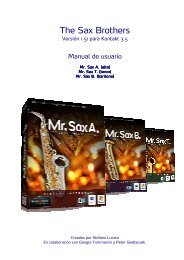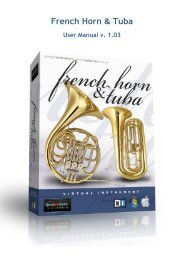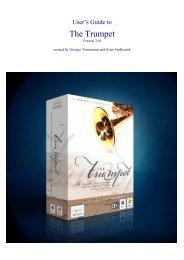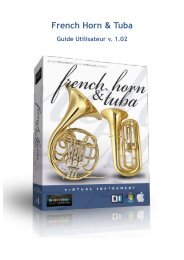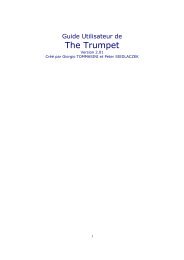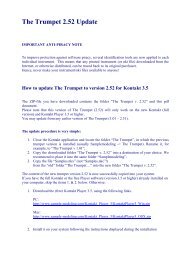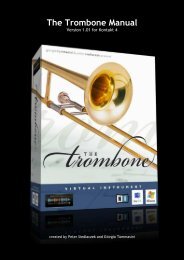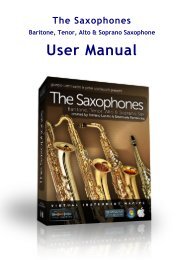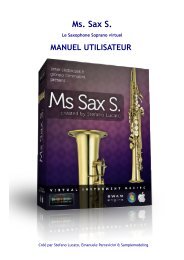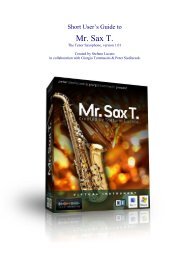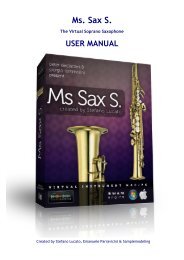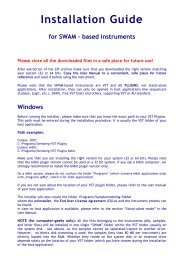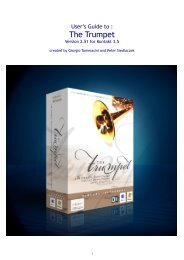Trumpet Presentation - Sample Modeling
Trumpet Presentation - Sample Modeling
Trumpet Presentation - Sample Modeling
You also want an ePaper? Increase the reach of your titles
YUMPU automatically turns print PDFs into web optimized ePapers that Google loves.
3<br />
Special Features<br />
Velocity Remapping<br />
It is well known that midi keyboards have different and uneven velocity response, and this may<br />
heavily influence the performance of a virtual instrument. To obviate this problem the instrument<br />
includes automatic detection of any velocity inhomogeneities or non-linearity emitted by the<br />
keyboard, and provides automatic remapping to any desired curve. Remapping of some midi<br />
controllers is also provided. This allows for example to remap CC7 to CC11, allowing for use of<br />
some high quality, but older keyboards which could output only CC7. Remapping of CC2 to CC11<br />
allows for use of a breath controller, such as Yamaha BC3, provided that your keyboard supports it.<br />
GUI Knobs<br />
All the controllers needed for proper functioning of the instrument are mapped to virtual knobs in a<br />
GUI panel, which can be activated by a drop down menu. This allows those users with keyboards<br />
without programmable MIDI sliders or knobs, to fully exploit the expressive capabilities of the<br />
instrument. The virtual knobs also allow for monitoring the incoming midi data, and can of course<br />
be automated when used as a plugin in an appropriate host application.<br />
Performance Keyswitches<br />
This is an outstanding new feature, allowing to create real time articulations which are too difficult<br />
to perform with the usual interplay of expression pedal, pitchbend and modwheel. Sforzato,<br />
crescendo, decrescendo, on-the-fly complex modulation patterns and different types of release, can<br />
be obtained by a simple touch on one of the keyswitches. The intensity of the effect, and its<br />
duration, are under player’s control. Please note that these are not just sampled articulations, but<br />
they are sample-modeled, indeed. This means that each time each of them will sound slightly<br />
different. No machine-gun nor mechanical repetitions here.<br />
Split Portamentos and Falls<br />
A real trumpet may play different types of legato/portamento, with or without valves. The sound is<br />
different, since a different harmonic resonance is excited. This is nicely reproduced by our adaptive<br />
model. One may choose to perform a continuous half-valve portamento over two octaves by simply<br />
overlapping two notes, to split it manually playing intermediate legato notes, or to split it<br />
automatically, exploiting the natural harmonic resonances of the instrument, using a single<br />
keyswitch. One can even choose to perform chromatically-split portamento or automated falls. Six<br />
different split portamento types and four different falls are activated by the touch of a keyswitch.<br />
Wah-wah effect<br />
The wah-wah effect is usually elicited by moving a plunger inside the bell. A very realistic<br />
reproduction of this effect is carried out by a simple touch on a keyswitch, with continuous control<br />
of the wah-wah intensity given by the expression pedal.<br />
3



